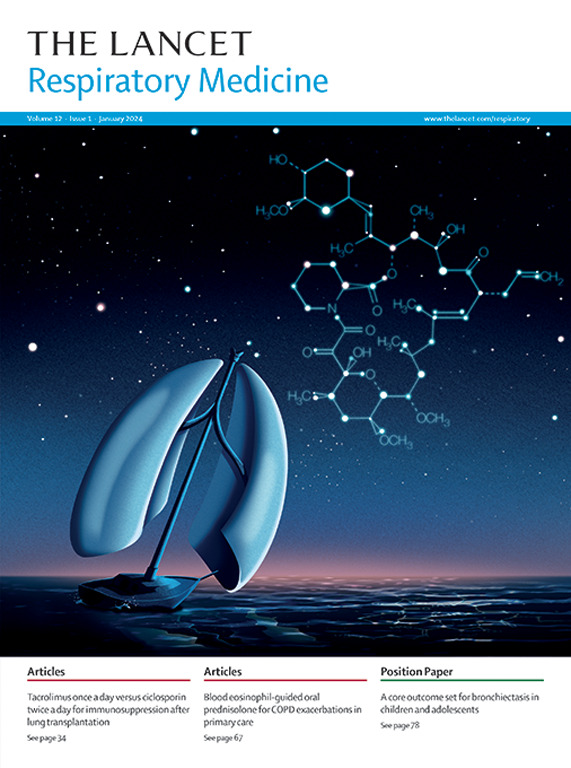2型炎症生物标志物及其与COPD (BOREAS) dupilumab应答的关联:一项随机、安慰剂对照的3期试验分析
IF 32.8
1区 医学
Q1 CRITICAL CARE MEDICINE
引用次数: 0
摘要
血嗜酸性粒细胞计数升高(≥300个细胞/ μL)是2型炎症的标志,可以识别慢性阻塞性肺疾病(COPD)患者有较高的加重风险。在BOREAS试验中,Dupilumab减少了COPD和2型炎症患者的恶化。在这项事后分析中,我们评估了BOREAS试验中接受dupilumab治疗的COPD和2型炎症患者的2型炎症生物标志物的预测价值和纵向变化。方法:boreas是一项3期、多中心、双盲、随机试验,在24个国家的275个地点进行,包括COPD和2型炎症患者(筛查血液嗜酸性粒细胞≥300个/ μL)。患者被随机分配(1:1),每2周接受300 mg dupilumab,持续52周或匹配安慰剂。随机化按国家和基线吸入皮质类固醇剂量分层。该事后分析评估了安全人群的血嗜酸性粒细胞计数、呼出一氧化氮分数(FeNO)、血清eotaxin-3、总血浆免疫球蛋白E (IgE)和血清肺和激活调节趋化因子(PARC)浓度。该研究已在ClinicalTrials.gov注册,编号NCT03930732,现已完成。boreas于2019年4月15日至2023年5月2日期间进行,包括939名COPD和2型炎症患者。468名患者被随机分配每2周接受300mg dupilumab治疗,持续52周,471名患者被随机分配接受匹配的安慰剂治疗。319名(34%)参与者为女性,620名(66%)参与者为男性。657例(70%)为既往吸烟者,282例(30%)为现吸烟者。在第52周,dupilumab与安慰剂相比,大多数生物标志物的中位百分比降低幅度更大(总IgE: - 22.5% [IQR - 30.4至- 16.5]vs - 0.9%[- 6.5至4.8];FeNO:−28·6%(57·−1 - 0]vs−6·9%(−35·7到25·0);eotaxin-3:−8·8%(15·6−−2·9]vs−0·4%(−5 6到5··0);帕洛阿尔托研究中心:−14·4%(−29·2 2·1)vs−0·8%(−13·9到17·2])。各治疗组嗜酸性粒细胞计数的减少相似。总体而言,恶化风险降低,基线血嗜酸性粒细胞计数(p= 0.0056)和基线FeNO (p= 0.043)较高的患者降低幅度更大。COPD和2型炎症患者接受dupilumab治疗后,2型炎症生物标志物降低,血嗜酸性粒细胞计数和FeNO升高预示着更大的治疗反应。这些发现支持生物标志物驱动的治疗策略来优化治疗。资助赛诺菲和Regeneron制药公司。本文章由计算机程序翻译,如有差异,请以英文原文为准。
Type 2 inflammation biomarkers and their association with response to dupilumab in COPD (BOREAS): an analysis of a randomised, placebo-controlled, phase 3 trial
Background
A raised blood eosinophil count (≥300 cells per μL), a marker of type 2 inflammation, can identify patients with chronic obstructive pulmonary disease (COPD) with higher exacerbation risk. Dupilumab reduced exacerbations in patients with COPD and type 2 inflammation in the BOREAS trial. In this post-hoc analysis, we evaluated the predictive value and longitudinal changes in type 2 inflammatory biomarkers in patients with COPD and type 2 inflammation from the BOREAS trial who received dupilumab treatment.Methods
BOREAS, a phase 3, multicentre, double-blind, randomised trial was conducted at 275 sites in 24 countries and included patients with COPD and type 2 inflammation (screening blood eosinophils ≥300 cells per μL). Patients were randomly assigned (1:1) to receive 300 mg of dupilumab every 2 weeks for 52 weeks or matching placebo. Randomisation was stratified by country and inhaled corticosteroid dose at baseline. This post-hoc analysis assessed blood eosinophil counts, fractional exhaled nitric oxide (FeNO), serum eotaxin-3, total plasma immunoglobulin E (IgE), and serum pulmonary and activation-regulated chemokine (PARC) concentrations in the safety population. The study was registered at ClinicalTrials.gov, NCT03930732 and is complete.Findings
BOREAS was conducted between April 15, 2019, and May 2, 2023, and included 939 patients with COPD and type 2 inflammation. 468 patients were randomly assigned to receive 300 mg of dupilumab every 2 weeks for 52 weeks and 471 were randomly assigned to receive matching placebo. 319 (34%) participants were female and 620 (66%) were male. 657 (70%) were former smokers and 282 (30%) were current smokers. At week 52, greater median percentage reductions were observed in dupilumab versus placebo for most biomarkers (total IgE: −22·5% [IQR −30·4 to −16·5] vs −0·9% [−6·5 to 4·8]; FeNO: −28·6% [−57·1 to 0] vs −6·9% [−35·7 to 25·0]; eotaxin-3: −8·8% [−15·6 to −2·9] vs −0·4% [−5·6 to 5·0]; and PARC: −14·4% [−29·2 to 2·1] vs −0·8% [−13·9 to 17·2]). Reductions were similar across treatment groups by blood eosinophil counts. Exacerbation risk overall was reduced, with a greater magnitude of reduction in those with higher baseline blood eosinophil count (p=0·0056) and baseline FeNO (p=0·043).Interpretation
Patients with COPD and type 2 inflammation who were given dupilumab showed reduced type 2 inflammatory biomarkers, with elevated blood eosinophil count and FeNO predicting greater treatment response. These findings support biomarker-driven treatment strategies to optimise therapy.Funding
Sanofi and Regeneron Pharmaceuticals.求助全文
通过发布文献求助,成功后即可免费获取论文全文。
去求助
来源期刊

Lancet Respiratory Medicine
RESPIRATORY SYSTEM-RESPIRATORY SYSTEM
CiteScore
87.10
自引率
0.70%
发文量
572
期刊介绍:
The Lancet Respiratory Medicine is a renowned journal specializing in respiratory medicine and critical care. Our publication features original research that aims to advocate for change or shed light on clinical practices in the field. Additionally, we provide informative reviews on various topics related to respiratory medicine and critical care, ensuring a comprehensive coverage of the subject.
The journal covers a wide range of topics including but not limited to asthma, acute respiratory distress syndrome (ARDS), chronic obstructive pulmonary disease (COPD), tobacco control, intensive care medicine, lung cancer, cystic fibrosis, pneumonia, sarcoidosis, sepsis, mesothelioma, sleep medicine, thoracic and reconstructive surgery, tuberculosis, palliative medicine, influenza, pulmonary hypertension, pulmonary vascular disease, and respiratory infections. By encompassing such a broad spectrum of subjects, we strive to address the diverse needs and interests of our readership.
 求助内容:
求助内容: 应助结果提醒方式:
应助结果提醒方式:


